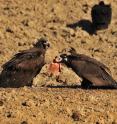The vulture's scavenging secrets -- an ironclad stomach and a strong immune system
Vultures have a unique genetic make-up allowing them to digest carcasses and guard themselves against constant exposure to pathogens in their diet, according to the first Eurasian vulture genome published in the open access journal Genome Biology. The study also finds that this species of Asian vulture is more closely related to the North American bald eagle than previously thought. The cinereous vulture or black vulture, Aegypius monachus, is the largest bird of prey, and an iconic bird in the Far East. The species plays a key role in the ecosystem by removing rotting carcasses, thus preventing the spread of disease.
As their feeding habits involve constant exposure to pathogens, vultures are suspected to have strong immune systems, having evolved mechanisms to prevent infection by the microbes found in their diet. Despite the potential interest in the immune system of scavengers, little is known about the genetic variations involved in vultures' immune processes.
Lead author Jong Bhak from Ulsan National Institute of Science and Technology, South Korea, said: "This is the first Old World vulture genome that has been reported, and we can see that the cinereous vulture has genetic signatures for resisting infection from eating decaying flesh. Understanding the genetic make-up of extreme life forms has potential for improving human health. The immune system genes we've identified could be useful targets in humans for protection against infection."
The team sequenced the genome of a cinereous vulture, and compared it to that of the closely-related bald eagle, the national bird of the United States, to find genetic signatures of the dietary and environmental adaptations that help enable the vulture's scavenging lifestyle.
Specifically, they found variations in genes related to the regulation of gastric acid secretion, consistent with their ability to digest carcasses. Other genetic variations included several in genes associated with immunity and defense against microbial and viral infections.
These included genes that allow cells to take up microorganisms and target pathogens for ingestion and elimination. The authors suggest that these may play a role in helping the vulture species combat pathogens encountered in their diet and complement the role of gastric secretion.
The term vulture refers to two groups of birds of prey that evolved independently, namely the Old World vultures, found in Africa, Asia and Europe, and the New World vultures, found in the Americas.
By analyzing its full genome, the researchers calculated that the Old World cinereous vulture species diverged from the North American bald eagle species around 18 million years ago. This split is much more recent than the divergence of the Old World and New World vultures around 60 million years ago. The results therefore add further evidence to the hypothesis that the two groups of vultures evolved their similar features and lifestyle independently in different locations.
Co-author Oksung Chung from the Genome Research Foundation, South Korea, said: "We were surprised that the cinereous vulture was so closely related to the bald eagle, compared to the more similar-looking turkey vulture in our analyses.
Co-author Yunsung Cho from the Ulsan National Institute of Science and Technology , South Korea, added: "The cinereous vulture appears to be somewhere in between a vulture and an eagle, and we could even regard it as a 'cinereous eagle' genetically speaking."
Source: BioMed Central
Articles on the same topic
- In an urban environment, not all vultures are created equalWed, 21 Oct 2015, 22:54:53 UTC
Other sources
- In an urban environment, not all vultures are created equalfrom Science DailyThu, 22 Oct 2015, 1:50:15 UTC
- In an urban environment, not all vultures are created equalfrom PhysorgWed, 21 Oct 2015, 22:00:07 UTC
- Vulture's scavenging secrets: Ironclad stomach, strong immune systemfrom Science DailyWed, 21 Oct 2015, 14:20:10 UTC
- The vulture's scavenging secrets—an ironclad stomach and a strong immune systemfrom PhysorgWed, 21 Oct 2015, 7:30:17 UTC

